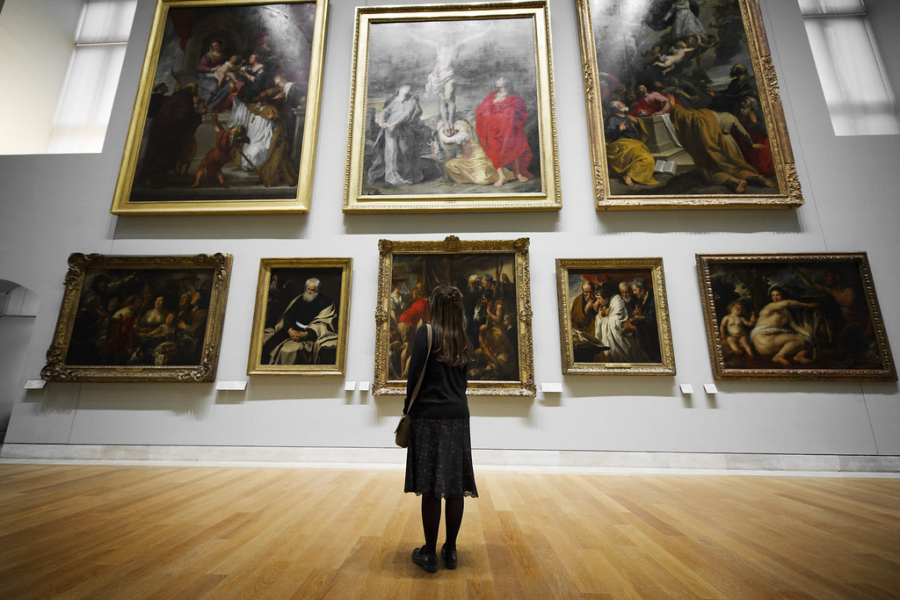Are NFTs the future of modern art?
“Non-fungible tokens are revolutionizing the art world — and art theft.” Dusty J// creativecommons.org
In 2008, Satoshi Nakamoto appeared online to propose a cryptic idea for the first entirely-digital form of currency: bitcoin. Over a decade later, musicians, digital artists and filmmakers are now trying to apply the technology at the core of cryptocurrencies to transform the way artists can sell their work.
This new form of cryptocurrency, called a non-fungible token, is taking the music industry by storm. These “collectible” digital assets may take the form of online art or music files. Each NFT is unique (hence, non-fungible) and therefore they essentially function as collector’s items in the form of a JPG file, for example. The information stored inside these files (art, music, videos, etc.) give non-fungible tokens value, so they can be bought and sold like traditional forms of art. Each NFT is connected to a blockchain, an unhackable digital spreadsheet that certifies the authenticity of each transaction, so it is impossible for individuals to pass off copied files as NFTs.
Over the past few weeks, non-fungible tokens have grown in popularity after buyers flooded the unregulated market with billions of dollars in hopes of striking it rich. Beeple, a digital artist, recently sold a piece of artwork in the form of a JPEG file for a record of $69.3 million at an auction. CEOs have raised millions for charity auctions by selling NFTs. A buyer resold an NFT for over three times its original price. The high demand for non-fungible tokens is based on the idea that online songs are valuable simply because they are exclusive.
However, NFTs have been highly controversial lately as counterfeit NFTs have become increasingly common. Non-fungible tokens have revolutionized the art industry—and plagiarism.
The concept of NFTs itself is intriguing. A piece of traditional art is bought because it is unique, but an NFT is valuable simply because of its uniqueness. Non-fungible tokens can also be extremely helpful for digital artists. Many people have attempted to profit off of their talent through monetization on social media or with commissions, so in a way, NFTs are just a new spin on old practices.
On the other hand, though, consumers might react differently to NFTs. People are used to digital work being accessible to everyone on the Internet. Traditionally, if digital art is posted online, it can easily be shared, saved and downloaded. There is not a strong sense of ownership because everyone can use it easily. Now, with NFTs, there is a way to give digital art a sense of uniqueness. The ownership factor is entirely based in a social context. The entire appeal of these tokens is about ownership and exclusivity. This could cause even more people to create programs that turn an artist’s work into digital objects to be sold to someone else.
Most of the digital art that is posted on the internet is free and accessible to everyone. Some people are copying free art from the internet to sell them as NFTs. Once the new owner of the file has made the purchase, the original artist’s free work is considered to be counterfeit. NFTs not only take away profits from online artists — they also rob them of their art ownership.
To many, this threat isn’t that relevant considering that they now have the ability to own the one-of-a-kind Nyan Cat image. Perhaps another issue surrounding the currency will sound more pressing: NFTs require incredibly high energy consumption. According to a Harvard study, increasing carbon dioxide emissions from Bitcoin mining alone could lead to a 2 degrees Celsuis increase in global mean average temperatures within 30 years. If this is true for cryptocurrency, what does that mean for cryptoart? The blockchain on which NFTs run uses about as much energy as the entire country of Ireland annually. The environmental cost of NFTs is not sustainable.
There is a lot of potential for the cryptoart market in the art industry. However, many changes would need to be made. The market needs to be regulated. Currently, there is no rule deciding who can create NFTs and who cannot. This enables people to plagiarize the works of artists and sell them for a lower price. To avoid this issue, there must be a way to verify that the piece was bought before it is placed back on the market.
Additionally, researchers need to find a more environmentally friendly way to run the NFT system. There is no justification for destroying environmental conservation efforts just for the sake of gambling on artwork that might be plagiarized. The minting and selling process of cryptoart is not at all respectful of our global energy supply, and that needs to change before this practice can continue.
I appreciate art. I believe that it has a tremendous impact on all cultures around the world. It’s fantastic that a new method has been developed for artists to share their talents, but the current state of cryptoart just isn’t sustainable. If the non-fungible token market were to be reconstructed, it could completely redefine the way art plays a role in our society. Until then, buyers should commission their local artists instead.












Daniel Cutler • Mar 26, 2021 at 8:31 pm
Thank-you for this article I appreciate it. That said, I wanted to clarify one very important point. Your article states that “NFTs require incredibly high energy consumption…The blockchain on which NFTs run uses about as much energy as the entire country of Ireland annually. The environmental cost of NFTs is not sustainable.” While it is true that NFT’s minted on the Ethereum blockchain using the ECR721 standard are extremely energy intensive, there are other, sustainable blockchains where anyone can mint/buy/sell NFT’s. One example is the Tezos blockchain which uses a proof of stake consensus model and is therefore much less energy intensive. It is also 20,000 times cheaper than minting on Ethereum! For more info: https://cryptoslate.com/one-of-the-worlds-biggest-nft-marketplaces-will-soon-begin-minting-on-tezos-xtz/